“Increasing curb appeal” is often used to refer to updating the exterior of your home when you’re selling it. But it can also mean creating a welcoming front yard for you and your family. Adding trees and shrubs can make any gathering more enjoyable by providing natural beauty and shade to your home.
What are the best plants for a front yard? While every landscape and climate is different, we have some great front yard plant ideas for you to consider.
The most beautiful front yard plants
All plants have their own beauty and can be perfect in a particular environment. That is why it is important to consider the location and setting of your home when choosing woody plants for your front yard. The best front yard plants are those that thrive in your location and climate and are suited to your family’s needs.
But some species seem tailor-made for the front yard – providing shade and/or ornamental value in a package small enough to function as great front lawn plants. Here are five of our favorites:
1. Flowering hawthorn tree (Malus spp.)
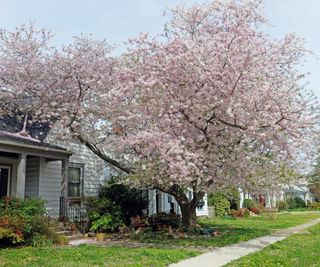
(Image source: Joe_Potato / Getty Images)
These small trees are extremely popular for front lawns because of their compact size, easy care, and fragrant, delicate spring flowers. They typically grow up to 20 feet (6.5 m) tall and wide, with green or maroon leaves and a profusion of pink or white flowers early in the season. Some trees also produce small, tart fruits that can be used to make jams or to feed wildlife. Flowering crabapples are hardy in USDA zones 4-8 and require full sun.
2. Populus tremuloides
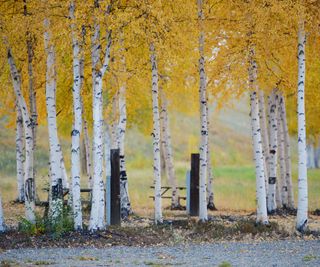
(Image source: p-orbital / Getty Images)
The quaking aspen is one of the most beautiful native trees, with leaves that seem to sway with every breeze. It can thrive in cooler climates – down to USDA zone 1! – and is a tree to consider for larger front yards. It is a sight to behold in the fall when its finely serrated leaves turn a brilliant yellow. The quaking aspen grows quickly, reaching heights of 20 to 50 feet, and can form clumps if left to grow naturally.
3. Japanese maple (Acer palmatum)
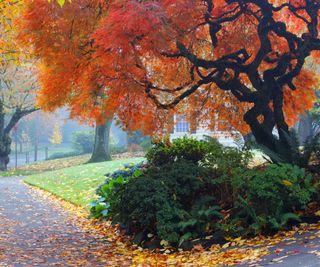
(Image source: DaveAlan / Getty Images)
The beautiful Japanese maple – beloved for its distinctive leaves – is certainly one of the best trees for a front lawn, partly due to the wide variety available. You can find Japanese maples ranging in height from 3 feet (1m) to 24 feet (8m) with growth patterns ranging from clumping to upright to weeping. Most have delicate lobed leaves that turn brilliant colors in the fall. They are hardy in USDA zones 5-9.
4. Ginkgo Biloba
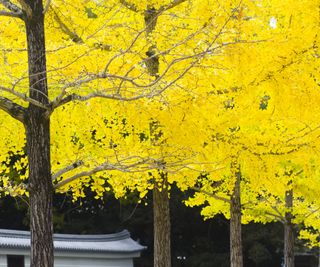
(Image source: Masahiro Makino / Getty Images)
Ginkgo trees are easily recognized by their unique fan-shaped leaves that turn a striking bright yellow in the fall. They are medium-sized deciduous shade trees that grow slowly to heights of 35 to 50 feet (5.5 to 16.5 m) in USDA zones 4 to 9. Purchase a male ginkgo tree to avoid the smelly ginkgo fruit produced by female trees. There are several male-only cultivars to choose from. Those with smaller front yards may want to consider “Pendula,” an umbrella-shaped ginkgo that reaches a maximum height of 8 feet (2.5 m).
5. Magnolia (Cornus florida)
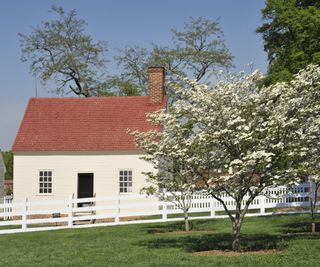
(Image source: aimintang / Getty Images)
The flowering dogwood is an extremely popular native tree. Growing to 30 feet (10 m) tall, the flowering dogwood is the perfect size to make a great front yard tree. And talk about trees! Spectacular white flowers cover the bare branches in the spring before the leaves appear, the leaves turn brilliant colors in the fall, and red berries persist into winter. Choose the size and characteristics you want from hundreds of cultivars. Most prefer shade and thrive in USDA zones 5 – 9.
How to Choose the Best Trees for Your Front Yard
Choosing the best tree for your front yard isn’t a matter of “falling in love” with a species. Trees will be an important part of your landscape for many years, so take the time to consider all the factors.
First, understand your hardiness zone, climate, and site conditions. Is the site sunny? What type of soil do you have? What size plants are best for your front lawn?
Second, consider practical issues like how well the plant can handle environmental conditions. Is it drought tolerant? Can it tolerate soil or air pollution? How much money are you willing to invest in maintaining your plant? Most homeowners will do well to skip plants that require higher levels of maintenance.
frequently asked Questions
How much maintenance do front lawn trees need?
The amount of maintenance a tree needs depends on the species and the location. All trees are easier to care for and more important when planted in a location appropriate to the species.
What characteristics make a tree unsuitable for planting in a front yard?
If a tree is likely to cause problems for the homeowner, it is considered undesirable for the front yard. For example, trees with invasive roots, trees that drop a lot of fruit, branches and debris, trees with smelly fruit, and trees that grow too tall are all undesirable.
